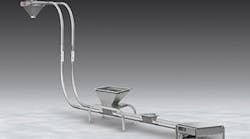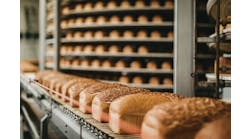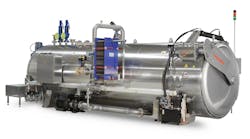Powders are among the most challenging substances to work with in food and beverage plants. One of the biggest challenges is getting them where they’re supposed to go.
Conveyors that move powders and bulk solids around need to accommodate a variety of handling requirements. Powders can be sticky, can agglomerate and can denature if exposed to excessive heat or moisture. Parameters including distance, path and required throughput can all affect powder conveying.
Several basic options, with different operational principles, are available for conveying powder. In some applications, the method will be dictated by the characteristics of the material; in others, several options will be available, and users will have to prioritize based on their relative advantages.
The most common type of powder conveying is pneumatic, where pressurized air either blows the material through a tube or a vacuum draws it through. There are two basic types of pneumatic conveying: dilute-phase and dense-phase.
Dilute-phase conveying basically means suspending powder in a continuous stream of air. It’s most suitable for low-density materials that are not abrasive, heat-sensitive or fragile and that need to move at a high rate; to make dilute-phase conveying work requires an airstream of between 5,000 and 8,000 feet per minute.
It’s versatile enough to discharge powder from any kind of container, notes David Kennedy, business development manager at Vac-U-Max. Dilute-phase conveying is preferred when an application has multiple pickup points for ingredients, such as a blended powder.
In dense-phase conveying, by contrast, the material is moved along by air but is not suspended in the airstream. It uses less air pressure and moves product more slowly, making it suitable for dense but friable or otherwise fragile material like sugar.
Because it uses higher vacuum levels, it draws more power, needs heavier and sturdier steel walls and other fabrication aspects, and is more prone to leaking. An in-between option is semi-dense-phase conveying, which uses a medium-velocity airstream in which part of the material is suspended. It’s suitable for abrasive or friable materials.
Another basic distinction with pneumatic conveyors is how product will be propelled: pushed with positive pressure at or near the intake point, or pulled by a vacuum at the discharge end.
Positive-pressure conveying is better to handle applications with high volumes (above 25,000 lbs. per hour) and long distances (more than 250 ft.), especially if the product has to be discharged at multiple points. It’s the best option when intake has to be done from a massive container like a silo or railcar, Kennedy notes.
It can be problematic for heat-sensitive material, due to the heat generated by the blower, although Kennedy says that this can be ameliorated with a heat exchanger. For intake from open-top containers like bags and totes, vacuum systems that use wands are probably better.
Modular construction is something end users should look for if they’re concerned about cleanability, says Rafael Navarro, president of Volkmann Inc.
“One common challenge among conveying system specifiers is cleanability,” Navarro says. “Our conveying systems are modular and can be disassembled without any tools for quick, complete access to the interior for cleaning.”
Air, metal or plastic?
Pneumatic conveyors are just one of the options for moving powders and bulk solids. Others are available, depending on needs that include footprint, throughput, energy efficiency, ease of maintenance and other factors. Many of these use mechanical principles instead of compressed air, and these usually are cheaper to operate.
One such system is tubular cable conveyors, which combine the advantages of totally enclosed operation with the reliability of mechanical action. These can differ in operational principles, but in general, they use disks strung on a cable or chain inside a tube. As the cable moves, the disks sweep the material forward.
Tubular cable conveyors are especially useful for applications that require a tortuous or unusual path; they can carry product up or down inclines easily, at nearly any angle.
“Unlike screw and bucket elevators which are limited to transport in a single direction, tubular drag conveyors can move product to and from multiple locations in multiple directions with a single system,” says Andrew Willse, product manager at Modern Process Equipment.
Drag conveyors can be roughly divided into two classes: disk-and-drag or aeromechanical. The former have disks that are relatively snug ¬ about an eighth inch of clearance, according to Cablevey marketing director Karl Seidel. They are relatively slow (about 100 ft. per minute) and low in throughput, but they handle product gently and so are good for fragile items like breakfast cereal.
“When wanting to design a complete system layout, tubular drag conveyors provide the most flexibility,” Willse says. “Tubular drag conveyors can also offer excellent clean-in-place options, whereas other types do not.”
Aeromechanical conveyors use slightly smaller disks that create more airflow. This makes them faster and more suitable for powders and solids with sturdy particulates, like coffee beans, that can stand up to faster, rougher handling. They have higher throughput, which they can achieve using relatively little energy.
One of their biggest drawbacks, due in part to the larger space between their disks and the tube walls, is difficulty in sanitation. They also need constant surveillance and preventive maintenance to guard against the cable or disks wearing out, and they’re not recommended for applications that have to run constantly, Kennedy says.
“Even with all of the technical advantages, they are less-desirable if ingredients are changed frequently and where extended operating time frames are required,” he says.
The turn of the screw
Other conveyance methods involve purely mechanical means, with no airflow involved. Flexible screw conveyors use augurs rotating within tubes to push product along. They’re low in both initial and operational costs, they can carry product over long distances and they’re a good choice for products that might clog a pneumatic or tubular cable conveyor.
Tubular conveyors, of various types, can carry powder around tortuous paths and can accept ingredients midstream. Photo: Flexicon
With adaptations, flexible screw conveyors can be made to carry fragile or brittle materials prone to breakage or crumbling, or ones that are otherwise problematic, such as with high moisture, fat or oil content. In addition, they usually don’t use filters, which means less maintenance.
“A flexible screw conveyor is a relatively simple design and generally the most economical choice, with efficient performance, high reliability and low capital and operating costs,” according to Flexicon. “When properly engineered and tested, it will provide excellent performance across a broad range of applications.”
One disadvantage to flexible screw conveyors is that they’re unidirectional – they can only carry product from a single point to a single point. They also tend to require more floor space than a pneumatic system.
Another is difficulty in cleaning. “The space between the auger (screw) and the tube in a flex screw may break up flaked or nugget-like products, and some easily fluidized powders can fall back down the tube if it is installed on a steep incline,” Kennedy says, although he adds that some newer models make it easier to remove and clean or replace the auger. In addition, unlike vacuum systems, flexible screw conveyors have no way to discharge directly from bags or totes; their contents must be dumped into the system’s feed bin, usually with a separate piece of equipment.
Bucket conveyors are another mostly mechanical alternative. They comprise a series of open containers, usually hinged to allow them to travel up and down inclines, into which product is poured in and tipped out. They can be open or enclosed to control dust.
Bucket conveyors are well suited to fragile solids and use relatively little electricity. Even though they’re bulkier overall than tube-based systems, they can be configured so that they take up relatively little floor space. They’re especially good for spaces and setups that require a lot of elevation.
On the negative side, they’re trickier to feed; they require a consistent inflow stream with as little variation as possible. Their relatively high number of moving parts make them tend to be noisier and more prone to breakdown.
Numerous alternatives exist for conveying powders and bulk solids. Sometimes the choice will be dictated by the nature of the product and the available space, but not always, meaning that end users will have to make choices based on their own priorities.


